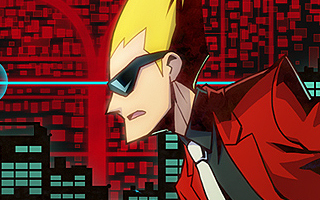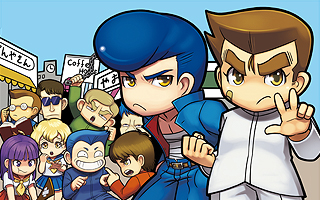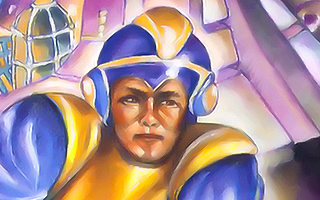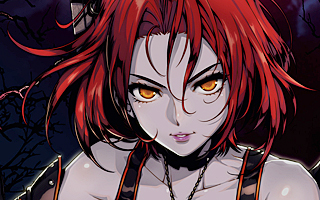Sega Genesis Nomad
Top 10 Best Sega Genesis Nomad Games of All Time!
In 1995, Sega released the Genesis Nomad exclusively in North America. The handheld system was marketed as a portable Genesis, and it was compatible with (almost) every game released for Sega’s iconic 16-bit console. We’ve already listed the greatest Genesis games, so you might be asking why the Nomad warrants a separate countdown. The Nomad’s 3.25″ LCD screen was susceptible to ghosting, and this made it inappropriate for many of the best Genesis games. Shoot ’em ups, run-and-guns, and fast-paced platformers didn’t translate well to the tiny Nomad screen, and many of the system’s flagship titles fell into one of these categories. Games that move at a slower pace are more appropriate for the Nomad, which was the very antitheses of Sega’s “Blast Processing” messaging. Portability is another concern, since the Nomad could eat six AA batteries in under three hours. If you can’t make meaningful progress in a game during your lunch break or on your morning commute, then the game’s probably not an great fit for the Nomad. Although the Nomad could be hooked up to a standard television, we’re going to focus entirely on the portable component since that was the system’s main selling point. What makes for a great console game doesn’t necessarily make for a great handheld gaming experience, and this countdown will try to keep that in mind.
10
Comix Zone
1995

Comix Zone is a creative brawler set within the pages of a comic book. The dialogue is displayed within speech bubbles, the characters are sketched-in before coming to life, and you progress through the stages by moving between static comic book panels. The premise of an artist battling his own creations is unique, and it’s exciting to move between one panel and the next. There are multiple paths to take through each stage, and you’ll occasionally have to smash through to the next panel like the Kool-Aid man breaking through a wall. (There’s one instance where the pages of the comic book start on fire, and you’re forced to race through the stage in a timely fashion!) The action is broken up into separate panels and there’s not a lot of scrolling, so the Nomad’s ghosting issues are alleviated. The game also has the best use of color I’ve ever seen in a Genesis game, and the high-contrast visual style works well on the Nomad’s screen. One of the biggest criticisms leveled against the game was how short it was. There are only six stages and you can easily finish it within a couple of hours, but that’s ideal for a portable console with an insatiable appetite for batteries. Comix Zone hit store shelves just a couple of months before the Nomad, and it was the perfect showpiece for Sega’s newly-minted handheld. Although the game doesn’t live up to its full potential, I completely understand why Comix Zone was prominently featured on the Nomad’s packaging.
9
Castle of Illusion Starring Mickey Mouse
1990

Mickey Mouse is the single most iconic cartoon character of all time, and he’s also had starring roles in many fantastic video games. The Venn diagram for Disney fans and video game fans was a perfect circle in the early ’90s, so it would be an understatement to suggest that Mickey was well-suited for the medium. Castle of Illusion was one of the most important Genesis games released before the arrival of Sonic the Hedgehog. Despite their best efforts, Sega had been unable to find a mascot that resonated with audiences in the same way that Mario did, but everyone knew who Mickey Mouse was. Castle of Illusion would have sold well based on the license alone, but Sega made a delightful platformer with memorable level designs. Whether you were fighting giant spiders in an enchanted forest or strolling around on giant cakes in a sugary wonderland, there was always something interesting to see. The colorful graphics look great on the Nomad, and Mickey’s floaty jumps make it easy to gauge where he’s going to land. Sega was all about Blast Processing during the height of the 16-bit wars, but Castle of Illusion proves that platformers don’t necessarily have to “go fast.”
8
The Lost Vikings
1994

The Lost Vikings was one of the first games developed by Blizzard Entertainment. (As a matter of fact, the company was still known as Silicon & Synapse when the game was released.) The premise of the game involves three Vikings who are kidnapped by aliens and intended to be used in an intergalactic zoo. By working together, the Vikings hope to escape from the aliens and find their way home. Each Viking has their own unique set of skills, of course, and you’ll need to figure out how to coordinate their abilities in each stage. Erik is the fastest of the three and has the ability to smash through enemies and walls with his helmet. Baleog is armed with a sword and can also fire arrows from a distance. Olaf is equipped with a shield that can block projectiles. The shield can also be used as a veritable hang glider, and the other Vikings can use Olaf as a platform to reach higher areas. The Lost Vikings is a puzzle game that thinks it’s a platformer, and the level designs are surprisingly creative. Although the game features a cooperative mode that allows for the Vikings to be controlled simultaneously, it’s more manageable for a single player to simply alternate between the three Vikings. It’s fun to figure out all of the puzzles by yourself, and the simple password system makes it an ideal handheld game since you can always continue where you left off.
7
Beyond Oasis
1994

Beyond Oasis is an action-RPG that could be likened to The Legend of Zelda or Secret of Mana, but there are a number of things that differentiate it from other games in the genre. There’s a heavy emphasis on combat, for instance, and the game almost feels like a beat ’em up that’s played from an overhead perspective. The weapon system was also creative. Although players could harness the power of elemental spirits to fight enemies or solve puzzles, many of the special items would break if you used them too much. This forced players to conserve their resources, and it prevented them from becoming too dependent on one particular weapon. I’ve always loved the game’s visual presentation, and I was especially impressed by some of the boss battles. At the same time, I thought the characters were too large and the movement was too slow for my liking. Ironically, these criticisms are part of the reason why the game works so well on the Nomad. It’s easy to follow the action, even on a small screen, and the game makes great use the system’s limited color pallet. Beyond Oasis is as clean as a whistle, and I’m taken aback by how vibrant it is. It almost feels like the game was made with the Nomad in mind.
6
Shining Force II
1993

The Shining Force games are fantasy-themed tactical RPGs with a few science fiction elements thrown in for good measure. The turn-based battles are a great fit for a portable system, and it’s easy to follow the action since the game uses a simple grid interface. I realize that a text-heavy game might seem out of place on this list, but the fonts are easy to read and the text doesn’t get lost in the background. As with most games in the genre, players have to be mindful of the positioning, attack range, and speed of their units. With the right tactics, you could surround your enemies, draw them into traps, or simply attack them head-on. Shining Force II retains the same basic gameplay of the original, but offers many quality of life improvements. The enemy AI is more sophisticated, refinements were made to the battle system and menus, and a new system for weapon synthesis was implemented. The game was also decidedly less linear than its predecessor, and you were given more freedom with respect to backtracking and character promotions. Since you were no longer locked into a rigid chapter system, you could potentially make some semblance of progress without being drawn into a lengthy battle or a brand new campaign. You’ll definitely want to invest in some rechargeable batteries, however, since the game will take upwards of 30 hours to complete.
5
Streets of Rage 2
1992

I’ve always held Streets of Rage 2 in high regard, and my appreciation of the game has only increased over time. While most beat ’em ups start to feel repetitive after a while, Streets of Rage 2 has a lot of variety with respect to its enemies, levels, and character movesets. Even though you can complete the game on a single set of batteries, there are plenty of reasons to jump back in after you finish it. The four playable characters each have their own abilities and special attacks, for instance, so the game warrants multiple playthroughs. Streets of Rage 2 improved upon its predecessor in nearly every conceivable way, and it’s also a better fit for the Nomad since the larger characters are easier to see on the small screen. It’s easily one of the best-looking beat ’em ups of the 16-bit era, and Yuzo Koshiro’s electronic soundtrack was ahead of its time. The only reason why Streets of Rage 2 isn’t ranked higher on this list is because the Nomad wasn’t a great platform for two-player games. A second player could potentially plug in a standard Genesis controller into the Nomad and share the screen, but I’d much rather have had the option to link two Nomad’s together so each player could have their own screen. Streets of Rage 2 offers a great single-player experience on the Nomad, but you should probably stick to the television screen if you’re looking for some multiplayer fun.
4
Castlevania: Bloodlines
1994

Of all the titles that were discussed on our list of best Genesis games, Castlevania: Bloodlines is the one that works best on the Nomad. The Castlevania series has always been known for its deliberate pacing, and the characters move relatively slow compared to similar games. This obviously helps minimize the problems with the Nomad’s notoriously blurry screen. (The game still has “ghosting” problems, but they’re caused by ghostly enemies rather than an LCD display!) Bloodlines is almost certainly the most underrated Castlevania game from the 16-bit era, and I love how quirky everything is. The levels contain all sorts of environmental hazards, and the game is loaded with creative visual effects. One stage was filled with mirrors that distorted the location of the platforms, while another takes place within the Leaning Tower of Pisa as it rocks back and forth. The German munitions factory is probably the most surreal stage, and it’s bizarre to battle armies of undead soldiers during the First World War. Although the game only has six stages, they feel radically different from one another. The game also gives you two characters to play as! Jonathan Morris is your typical whip-wielding Castlevania protagonist, while Eric Lecarde arms himself with a spear that can be used as a makeshift vaulting pole. You can easily finish the game in a single setting, but Castlevania: Bloodlines is the kind of game that will keep you coming back for more.
3
Dr. Robotnik’s Mean Bean Machine
1993

Anyone who has played Tetris on the Game Boy can attest to the fact that puzzle games and portable systems go hand-in-hand. Dr. Robotnik’s Mean Bean Machine is the perfect game for the Nomad. Although the action is fast-paced, the screen doesn’t scroll and the colors are bright. The object is to line up similar colors and potentially create chain reactions, and this premise works just as well on a small screen as it does on a television. Like most great puzzle games, Mean Bean Machine is easy to pick up and play, and it’s something that you could jump into during your coffee break. One of the big selling points of the game was its competitive two-player mode, so it’s unfortunate that there wasn’t a way to link two Nomad’s up with each other. (Although you could potentially hook up a standard Genesis controller for two-player games, this setup was less-than-ideal due to the poor viewing angle of the Nomad screen.) That being said, the single-player “scenario mode” is still a lot of fun, and the CPU opponents are surprisingly competent. In some regards, the Game Gear version provides a better handheld experience. Not only could Game Gear owners link their systems together for a proper two-player experience, but the Game Gear version also featured an exclusive puzzle mode. The game obviously looks and sounds better on the Nomad, however, and it’s still the best puzzle game on the system by a considerable margin.
2
Ristar
1995

Sonic the Hedgehog was the single most important Genesis game of all time, and the system was defined by the series in a lot of ways. Unfortunately, the franchise was not ideal for the Nomad since the LCD screen didn’t play nice with fast-moving games. (Portability was also a concern in the case of Sonic & Knuckles, and it was downright unwieldy when you had other cartridges locked onto it.) Ristar is a spiritual successor to Sonic the Hedgehog and has a similar visual presentation, but it moves along at a much slower clip. Although it’s one of the most colorful games on the platform, the fine details are easy to make out on the Nomad screen. Ristar is basically a bright yellow star with arms, after all, so he never seems to get lost in the background. Platformers were a dime-a-dozen during the 16-bit era, but Ristar has plenty of innovative play mechanics. Ristar’s extendible arms could be likened to rubber bands, and they’re used in all sorts of creative ways. The little guy can latch onto ledges, grab onto enemies, and swing around on poles to slingshot himself into the distance. Although Ristar looks harmless, he’s one of the most metal protagonists of the 16-bit era. It’s not everyday you run across a video game hero who defeats their foes by smashing into them with their face! The blazing speed of Sonic the Hedgehog is a great fit for a TV screen, but if you’re looking for an inventive platformer to play on the Nomad, I’d recommend Ristar.
1
Crusader of Centy
1994

Crusader of Centy was the closest thing Genesis owners had to a Zelda game, and it probably would have been a huge hit if it didn’t arrive so late into the console’s life cycle. The whimsical adventure game primarily focuses on exploration and sword fighting, and there are tons of cool power-ups to find along the way. In lieu of traditional weapons, you are joined by various animal companions that give you special abilities. You’ll meet a penguin that grants ice powers, a dinosaur that can walk over hazards, and a butterfly that allows you to control your sword in the air after it’s thrown. Some of the abilities can even be combined together! Many animal buddies will allow you to gain access to areas that were previously inaccessible, but it’s hard to get lost since the game uses a simple map screen instead of a giant interconnected game world. Crusader of Centy can be broken up into easily digestible pieces, and this makes it an ideal handheld game. The graphics are a great fit for the Nomad, too. The backgrounds are colorful, the sprites are large, and the animation is fantastic. Even the text boxes and menus are perfectly legible on a small screen. Crusader of Centy arrived mere weeks before the release of the Saturn and it was largely ignored by the gaming press, but it was one of the best reasons to pick up a Nomad in 1995.





Do you agree with this list? Let us know what you think by leaving a comment below. Your opinion matters!